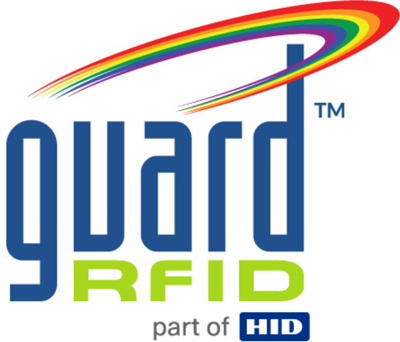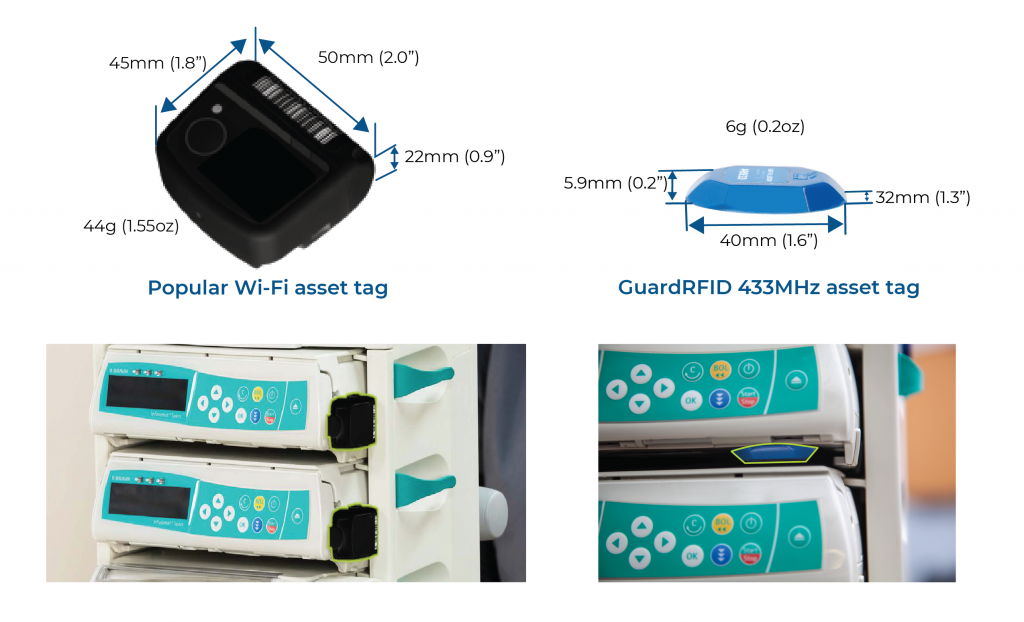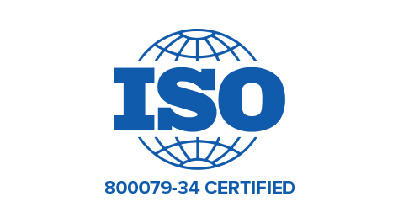Real-time location systems (RTLS) offer organizations a flexible, multi-purpose means to track people and assets to keep them safe. Using radio-frequency identification (RFID) technology, tags are worn by personnel and patients or are attached to expensive assets to locate them or restrict their movement.
There is a range of systems that provide RTLS, and two of the most robust options are Active RFID systems that use Wi-Fi or 433MHz frequency. But what’s the difference, and how do you know when to select one over the other?
What are 433MHz and Wi-Fi Active RFID?
433MHz is an un-licensed wireless radio frequency band. GuardRFID has implemented a purpose designed protocol to utilize this frequency band for RTLS using Active RFID technology. This protocol achieves very low average power for the tags.
The Wi-Fi (802.11 protocol) was designed to use the 2.4 GHz and 5 GHz frequency bands for Local Area Network data communications. RTLS has been implemented as an add-on use case, which causes a higher average power draw for tags than the 433 MHz Active RFID protocol.
An advantage of the 433MHz option is the range and performance in the presence of absorbing materials such as walls, metal objects and human bodies. Penetration of RF signals is inversely related to frequency, and better penetration is achieved at 433 MHz than at 2.4 GHz, which means that 433MHz Active RFID performs better in situations where tags are attached directly to people.
In the Gartner report, ‘Critical Capabilities for Indoor Location Services’, published in 2020, it was noted that “Technologies such as Wi-Fi are used for proximity tracking where the use case does not require granularity. Frequencies such as 13.56 MHz, passive UHF, BLE or UWB are often used for zonal tracking when they are integrated into ID tags, wristbands or security badges that detect where employees are at a specific time and date. Other frequencies such as 433 MHz will go through the human body and are best when maintaining contact is imperative.”
Both 433MHz and Wi-Fi Active RFID systems have similar capabilities, in terms of location accuracy, in that they can track a tag to an accuracy of three to four metres. Typically, this level is sufficient to meet an organization’s needs. However, sometimes this can place a tag in an adjacent room or on a floor above or below its true location. If more specific accuracy is required, a supplementary proximity detection mechanism can be added to either solution to detect movement through a doorway or stairwell.
Both system options have other benefits and limitations to compare. To determine which system will work best for your organization, consider the following factors: environment; RF coverage and interference; value of assets and flight risk; and types of tags.
Review the environment
One of the advantages of deploying an RTLS system using Wi-Fi is that it can be built utilizing the organization’s existing Wi-Fi infrastructure. In this scenario, only one wireless infrastructure will need to be managed and maintained, instead of two different systems. Although this option can save on cabling and maintenance costs, there are other set-up costs with a Wi-Fi system. The organization’s IT team will need to be involved during the deployment to survey the facility and calibrate the Wi-Fi access points.
One of the challenges of having a Wi-Fi based system that links to existing infrastructure is that it also poses some risk of outside interference or cyberthreats between systems. Further, as an “add-on” solution to wireless data communications already in place, it may not suit all needs.
Alternatively, in a greenfield deployment of a 433MHz solution, in which tracking and location services are the only use, a tailor-made solution can be implemented. This option provides quicker response times for situations that require access control to restricted areas or facility exits, and alarms, as it is a dedicated solution and doesn’t share data traffic.
RF Coverage and interference
In a busy facility, there can be considerable wireless interference from Bluetooth or IoT devices in operation. 433MHz Active RFID tags offer stronger immunity to interference than Wi-Fi tags, and so ensure that critical alarms are always detected. Since Wi-Fi is affected by absorption from the body and building materials, it has a smaller range and poor wall penetration compared to the 433MHz option.
Value of assets and flight risk
In the case of wandering patients or high-value assets and the potential flight risk they pose, a dedicated 433MHz network is a better choice, due to the increased RF coverage and reduced interference from other wireless devices.
Tags for two systems
Tags which use 433MHz Active RFID technology are smaller and lighter than Wi-Fi tags, and have a longer lasting battery life. So, it’s important to think about your use case. Are tags going to be worn by infants, or attached to small but expensive pieces of equipment?
In addition, consider how long each tag holds a battery charge. A Wi-Fi infant tag will need to be recharged at least every ten days, whereas a 433MHz tag will last 12 months.
433MHz asset tags and personnel tags cost less than Wi-Fi tags. However, this is offset by higher infrastructure costs of the 433MHz system over Wi-Fi, which can be built onto an existing Wi-Fi network.
Another factor to consider is the value of the asset or equipment being tracked. For example, it is not economically feasible to attach a tag to an asset that is disposable or costs less than the tag itself. On the other hand, it can be well worth attaching a small tag to an expensive yet small asset to save it from theft, or save the time it takes for staff to search for it. For instance, a popular Wi-Fi asset tag’s size can be 50mm x 45mm and 22mm high, while a 433MHz tag will be 40mm x 32mm and up to 6mm high.
Launching a real-time location system is a considerable investment, so be sure to walk through all of the key factors that will help you decide on a system that’s the right fit for your organization.



